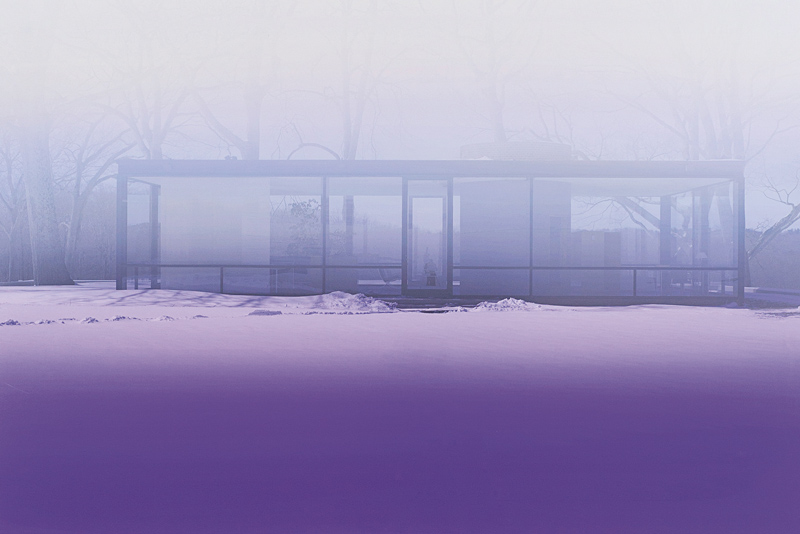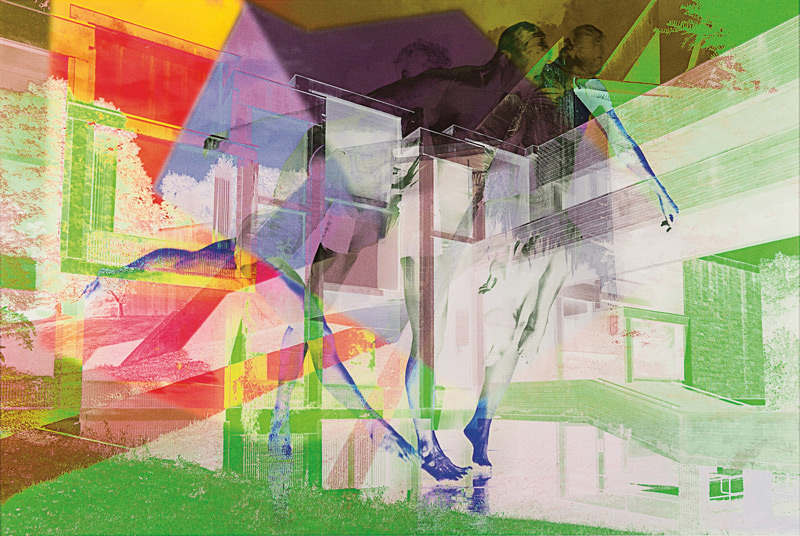[Spring-Summer 2017]
Galerie Marian Goodman, Paris
January 25–March 2, 2017
By Philippe Guillaume
An initial impression on entering James Welling’s exhibition in the large space of the Galerie Marian Goodman in Paris is that this is a group exhibition. There are several bodies of work, apparently disparate. However, relying on the knowledge that this is a solo exhibition by a single artist, James Welling, we might begin to consider that there is a James Welling, curator, “behind” James Welling, photographer.
This exhibition, aptly titled Chronology, presents a selection of work from Welling’s early days in the 1970s and from recent production. The artist’s principal interests lie in the area of photographic materiality and some of its attendant themes – colour, technologies, and abstraction – and to the social relations inherent in the production and circulation of photographs. The earliest works in the show, the group titled Polaroid (1976), are smaller in scale and more intimate than the later works, which are as diverse as Meridian (2014), a near-documentary depiction of a printing plant, and the series Chemical (2015–16), a boundary-blurring blend of painting and photography. Between these extremes would be New Flowers (2016), a series in which Welling emphasizes compositions composed of near-abstract and colourful layerings. In the series Choreograph (2015), he evidences his continuing commitment to working with colour, in this case digitally multi-layered compositions that include human figures in dance poses. The series The Glass House (2014) features photographs of the eponymous Phillip Johnson house in all its transparency – but tinted. In the slightly older grouping titled Degradés (2005) are works belonging to Welling’s non-camera body of works and photograms. In spite of the apparent abstractness of these compositions, Welling continues the logic of a certain realism, or documentary approach, simply by treating photographic praxis as a set of instructions to be followed, even if the project that he sets out is “authorial.” It is in this sense that he is a classic conceptualist and not the “near-painter,” or near-modernist, that he at times might appear to be.
Finally, a film is projected in a darkened room at the end of the basement level. Seascape (2017) is a colourized 16 mm film of ocean waves breaking on rocks – a familiar cliché scene for amateur painting, here transformed by the addition of a minimalist musical composition. The repetitiveness of the film loop combines with the musical score, featuring an accordion playing over the driving and pounding surf scenes, to create an intensely uncanny sense of disjunction, or, in more human terms, of the fragility of our suspension in time, of mortality.
What we get from this heterogeneous arrangement is the artist’s emphasis on working procedures and on his art practice, the first being a matter of particulars and the latter being comprehensive. The formulation of an art practice as “experimental” has been exemplified by Michael Snow and Hollis Frampton, and this agenda leaves its mark in Welling’s oeuvre. It is an interest that continues to inhere throughout his work and that both separates him from and connects him to artists, such as Thomas Demand, whose use of photography is relatively instrumental. Welling also explores the instrumentality of photographic technique – the idea that the camera simply registers what is in front of the lens as an explanation of how a photograph comes into being. Both he and Demand extend this notion through pre-executive decision making: Demands photographs of reconstructions of his subjects, whereas Welling programmatically organizes bodies of work in thematic series.
The role that Welling plays is always that of photography student. He faithfully follows photography as if the historical body of practices were instructions that he must decipher. In this sense, we might say that photography is “imposed” on him, although he reinserts subjectivity at the point of planning his themes, topics, or subjects. His work thus demonstrates the “objectivity” of the photographic apparatus and the seeming “passivity” of the photographer, subject to contingency and accident. This, along with ambiguity as to whether abstraction or reference is dominant, leaves his work with a significant degree of vulnerability. It separates him from any account of his work as modernist – and this thread can be seen right through to Seascape, in which all referents are suspended and we are left longing for an imagined lost plenitude.
A lasting impression gained from this exhibition is that any one body of Welling’s work exists in an ongoing interaction with the totality of his production. Seeing any one body on its own would clearly diminish its importance. This connects him with the discourse of conceptualism, but it also is a dimension of permission that he uses to play off some characteristics against others and to differentiate the “merely pretty” from the truly beautiful, and perhaps even the artistically true.
Stephen Horne is a Canadian art writer living in France.


